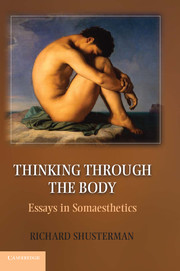Book contents
- Frontmatter
- Contents
- Preface
- Introduction
- Part I Somatic Being, Knowing, and Teaching
- Part II Somaesthetics, Aesthetics, and Culture
- 6 Somaesthetics and the Limits of Aesthetics
- 7 Somaesthetics and Burke's Sublime
- 8 Pragmatism and Cultural Politics
- 9 Body Consciousness and Performance
- Part III The Arts and the Art of Living
- Select Bibliography
- Index
- References
7 - Somaesthetics and Burke's Sublime
Published online by Cambridge University Press: 05 November 2012
- Frontmatter
- Contents
- Preface
- Introduction
- Part I Somatic Being, Knowing, and Teaching
- Part II Somaesthetics, Aesthetics, and Culture
- 6 Somaesthetics and the Limits of Aesthetics
- 7 Somaesthetics and Burke's Sublime
- 8 Pragmatism and Cultural Politics
- 9 Body Consciousness and Performance
- Part III The Arts and the Art of Living
- Select Bibliography
- Index
- References
Summary
I
Targeting his influential predecessors Immanuel Kant and Arthur Schopenhauer, Friedrich Nietzsche mordantly mocks the dogma of aesthetic disinterestedness, which defines beauty in terms of a purely disinterested pleasure that is inconsistent with will and desire. He denigrates this attitude as an expression of the prudish innocence of philosophers, whose second-hand, spectator's view of art compares unfavorably to the creative, hands-on, passionately desiring experience of the artist. The power of art and beauty, Nietzsche argues, derives not from disinterest but rather from “the excitement of the will, of ‘interest”’ (“die Erregung des Willes, ‘des Interesses’”). “When our estheticians tirelessly rehearse, in support of Kant's view, that the spell of beauty enables us to view even nude female statues ‘disinterestedly’ we may be allowed to laugh a little at their expense. The experiences of artists in this delicate matter are rather more ‘interesting’; certainly Pygmalion was not entirely devoid of esthetic feeling.”
Such failure to appreciate the role of will and sensuality in aesthetic experience, Nietzsche suggests, is linked to a much more general philosophical bias toward ignoring the somatic dimension of the aesthetic. This neglect derives not only from an idealist-rationalist repugnance for the body but also from a corresponding ignorance of the “Physiologie der Ästhetik” whose issues and import, he complains, “have scarcely been touched to this day.” Edmund Burke's aesthetics provides an important exception to Nietzsche's claim. Not only does Burke recognize that interest and even sexual desire are compatible with the appreciation of beauty, his theory of the sublime similarly implies the notion of interest while also offering a physiological explanation of our feelings of sublimity that explicitly defines certain conditions of our nerves as the “efficient cause” of such feelings.
- Type
- Chapter
- Information
- Thinking through the BodyEssays in Somaesthetics, pp. 145 - 165Publisher: Cambridge University PressPrint publication year: 2012



